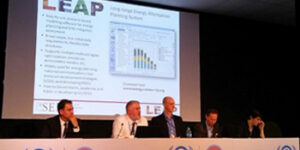
Photo: Marion Davis
In the lead-up to the Paris Climate Change Conference in December 2015, countries around the world are exploring what role they could play in global emission reduction efforts, which will be communicated as pledges called “intended nationally determined contributions” (INDCs).
As evidenced by the heated debates in Lima, which stretched the conference well past its scheduled ending, multiple factors will play into the scope and ambition of INDCs – most notably what governments perceive as fair and in their citizens’ interests.
But at least as important is what is actually possible: some countries have ample renewable-energy potential, for example, while others do not; some still have large populations without electricity, and cooking with firewood; others are middle-income countries where increasingly, emissions are driven by the consumption of burgeoning middle classes.
Two major interlinked projects, CLIMACAP and LAMP (Latin America Modelling Project), sponsored by the EU and the U.S. government, respectively, have been exploring the potential for mitigation in Latin America – both across the region, and specifically in Argentina, Brazil, Colombia and Mexico. SEI is part of the CLIMACAP team, and it has also worked extensively with Latin American countries using the LEAP (Long-range Energy Alternatives Planning) tool.
On 12 December, SEI and the CLIMACAP/LEAP coordinators co-hosted a side-event to share project findings and discuss more broadly how international and national-scale models can inform more ambitious climate policies. Mónica Araya, co-founder of NIVELA and Costa Rica Limpia, two NGOs focused on low-carbon and sustainable development, moderated the event.
“The framing question is: What happens when you look at what is possible in the region?”she said. “As you know, our countries are looking at making long-term commitments, and we need to know where the potential is, and what happens once we have these numbers.”
Bob van der Zwaan, coordinator of CLIMACAP, began by introducing the two projects, which aim to strengthen climate change mitigation modelling in Latin America, improve the representation of Latin America in global models, develop national models, and encourage the development of low-carbon policies.
Leon Clarke, coordinator of LAMP, noted that almost all models show greenhouse gas emissions in Latin America continuing to rise without new climate policies, due to rising GDP and growing populations. The energy-intensity of most economies is declining, but not the GHG-intensity of the energy supply.
Global models suggest that by 2050, emissions have to drop by 50% for adequate climate protection, Clarke said, but Latin America’s trajectory suggests the region will likely not need to reduce emissions quite so sharply. CLIMACAP and LAMP considered a wide range of mitigation scenarios, including carbon taxes and other efforts to cut emissions by as much as 50% of emissions by 2050, economy-wide or just from fossil fuel use and industry. The model results span a considerable range, however, particularly for land use.
Overall, van der Zwaan said, “if one starts imposing a significant carbon tax, then low-carbon technologies will be significantly enhanced” – particularly solar and hydropower. Yet fossil fuels are also expected to continue to play a large role through 2050. In Mexico, for example, the question is how much renewable technologies will be able to grow on top of existing fossil fuel use. It also appears that carbon capture and storage (CCS) is likely to be needed, he said.
SEI’s Charlie Heaps, developer of LEAP, focused his presentation on how national planners can develop similar studies in their own countries. He started by explaining the capabilities and limitations of global multi-regional models vs. national-scale models, and the lessons that each can learn from the other.
“International models are good at the global and regional scale, but need to be ground-truthed by local detailed knowledge that can only happen at the national scale,” Heaps said. Their assets include consistent methodologies – which allow comparisons across countries; their ability to capture the implications of energy trade and simulate where emissions can be reduced most cost-effectively; and their ability to model specific issues, such as the potential for biomass with CCS, which would be too difficult or expensive to model at the national level.
“But international models are not immediately transferable to the national context,” he said. They tend to be complex, are developed by experts for experts, and are not easy for policy-makers to understand. National models, meanwhile, can better reflect national circumstances, such as available energy resources, the local cost of each technology, and key policy barriers.
“National models also need to learn from international models, though,” he added, noting that they can otherwise be too conservative, ignoring options with great potential that seem infeasible at the moment. They can also lack objectivity, especially if run by government agencies, which need to calibrate models against sometimes overly optimistic national planning targets.
To show key aspects of a useful national model, Heaps briefly demonstrated LEAP, showing how different policy levers could be adjusted to immediately gauge the impact of a measure on emissions, energy security and other factors.
Finally, Nicolás Di Sbroaivacca, vice-president of Fundación Bariloche, in Argentina, presented results from CLIMACAP work using LEAP in Argentina, and also spoke more broadly about joint efforts with SEI to build modelling capacity across Latin America, including annual training workshops since 2000 that have trained more than 300 people.
A key message that emerged from the discussion is that to be effective at informing ambitious climate policy, models have to be developed in close collaboration with decision-makers and other stakeholders.
“It’s not viable to be effective in doing informed policy-making if the analysts work in an ivory tower with no link to reality, and policy-makers don’t engage at all with the analysts,” Clarke said. “You need interaction – not just one meeting or presentation, but it needs to be done jointly. That interaction also allows you to address challenges to implementation.”
Learn more about CLIMACAP/LAMP (external link to project site)
Learn more about LEAP (external link to COMMEND)
Design and development by Soapbox.